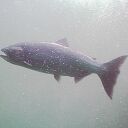


The southern resident orcas live in the Salish Sea and Pacific Ocean near the Pacific Northwest. There are three orca pods: the J Pod, the K Pod, and the L pod, with a combined population of 73 orcas (as of December 2022). The population of the southern residents has fluctuated throughout history, but it has been slowly declining.
Orcas can eat fish, birds, cephalopods (squid, octopus, nautilus), and even mammals, but the southern residents have only been known to eat fish. They mostly eat salmon, but also eat a small amount of other fish like the Pacific herring. The most common type of salmon that they eat is the Chinook salmon.
Orcas communicate using underwater sounds called clicks, whistles, and calls. Clicks are used for echolocation so that orcas can detect their surrounding environment. Whistles and calls are used to communicate with other orcas. Whistles are used for long-range communication, and calls are used for short to medium-range communication.
There are many problems that affect the southern residents, almost all of them caused by humans. The problems described on the "Problems Affecting the Southern Resident Orcas" web page are the following:
All of the problems that affect the southern residents have solutions, but some solutions are more feasible than others. As a result, only some of these solutions have actually been implemented. The solutions that have already been implemented have made some progress in southern resident recovery, but more action is needed in order for a full recovery of the southern residents to occur.
Recovery Plan for Southern Resident Killer Whales by the National Marine Fisheries Service, 2008
Center for Whale Research web site
All uncredited images and sounds are in the public domain.